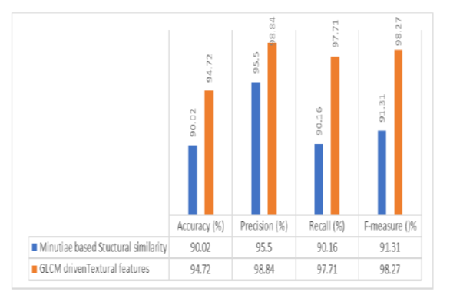


Indian Journal of Science and Technology
DOI: 10.17485/IJST/v15i44.1471
Year: 2022, Volume: 15, Issue: 44, Pages: 2375-2385
Original Article
K C Deepika1*, G Shivakumar2
1Assistant Professor, Department of E&C, Malnad College of Engineering, Hassan, Karnataka, India
2Professor, Department of E&I, Malnad College of Engineering, Hassan, Karnataka, India
*Corresponding Author
Email: [email protected]
Received Date:19 August 2022, Accepted Date:29 September 2022, Published Date:30 November 2022
Objectives: The Recent COVID 19 Pandemic has capped the efficacy of the mostly used existing touch-based fingerprint detection. Hence, the main objective of this study is to develop a lightweight, robust and efficient touchless fingerprint identification model. To cope up with touchless environment demands, an emphasis is made on improvement in local conditions, feature modalities as well as learning environment. Methods: Considering these objectives, the focus of this study is on two different methods for classification of contactless fingerprint. In the first method structural features like minutiae details are extracted followed by classification by SSIM. In the second method GLCM textural features were extracted followed by classification using Random Forest algorithm. In the proposed method, performance assessment is done by considering data samples of 1000 random users that are collected from different benchmark databases like Hong Kong Polytechnic University 3D-fngerprint images Database Version 2.0, Touchless Fingerprint Database of IIT Bombay, IIT Kanpur, IIT Jodhpur. Findings: Though, touchless fingerprint detection is considered as a viable alternative; yet, the real-time data complexities like non-linear textural patterns, dusts, non-uniform local conditions like illumination, contrast, orientation make it complex for realization. Moreover, the likelihood of ridge discontinuity and texture damages can majorly limit its efficacy. Novelty: The proposed model mainly focusses on reducing Equal Error Rate and improving the accuracy of contactless fingerprint classification by extracting textural features rather just sticking to conventional structural feature-minutiae. The Proposed method outperforms when compared with the existing state of the art methods by achieving an accuracy of 94.72%, precision of 98.84%, recall of 97.716%, FMeasure 0.9827 and a reduced EER of about 0.084. The key novelty of this approach was that it doesn’t require any surface 3D reconstruction, rather it employed different mathematical approaches to retrieve surface normal and minutiae information.
Keywords: SSIM; GLCM; Contactless Fingerprint; Minutiae; EER; Confusion Matrix
© 2022 Deepika & Shivakumar. This is an open-access article distributed under the terms of the Creative Commons Attribution License, which permits unrestricted use, distribution, and reproduction in any medium, provided the original author and source are credited. Published By Indian Society for Education and Environment (iSee)
Subscribe now for latest articles and news.